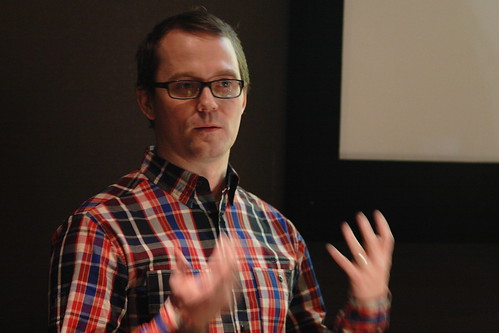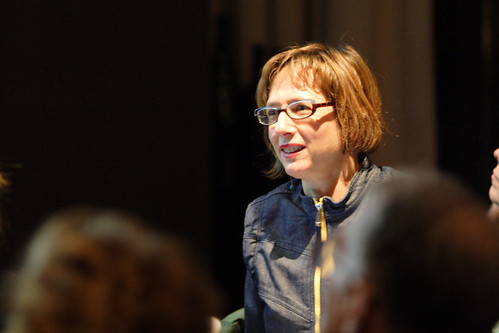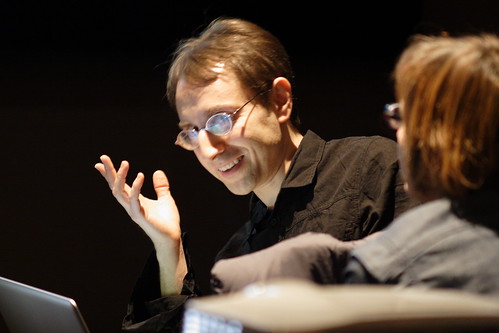January's salon
Posted by isabelwd / February 3rd, 2011 / 2 ResponsesJanuary’s get-together found us in the Eventi Hotel on 30th and 6th, overlooking the plaza that is home to the Big Screen Project.
Marius Watz was the first presenter. Growing up in Norway, he found his interest in 3d imagery was not supported by the institutions of the day, so he made his own way. Inspired by 90s rave posters, he developed his practice around generative art, using code as a native medium. His website showcases a dizzying array of projects, from code-based data visualizations to laser-cut works using wood and small rapid-prototyped sculptures. One highlight was ElectroPlastique, a work that took Victor Vasarely’s Op-Art paintings as a starting point. Over time, the Modernist grid evolves and devolves, oozing color and form, then shattering into bright triangles that fly apart. Like many abstract painters before him, Watz is also interested in music. He has worked as a VJ and created pitch-visualizations of jazz and electronic music. He also organizes the Generator.X conference and exhibition, a curatorial platform that brings together artists, designers, musicians and performers working with code.
Claudia Hart followed. Describing her work as “as opposite as you can get” to Watz’s generative imagery, she chronicled her struggles with the hypermasculinist gaming and 3d industry. Hart began as one of a very few female artists working in 3d, a culture that was often unwelcoming and hostile. She showed several cringeworthy artifacts from the recent past, including a render of a bikini babe atop a disturbingly phallic machine – which was presented totally uncritically as a tech demo at SIGGRAPH in 1996. Her response to this was to create imagery that was feminine, decorative and delicately subversive. She modeled a nude woman as a figure study for a class, and discovered that while the students was inured to overt sex and violence in 3d graphics, they found the sensuality of her imagery uncomfortable. Works like Ophelia and The Seasons exploited this tension. Fortunately other artists have joined Hart in critiquing and expanding gaming culture, but between booth babes and military-issued PC games, we still have a long way to go…
I presented next. I was grateful to be following Claudia, as she conveniently summarized my own divided position as an artist working with the collision of technology, art history and the female body. I began working with 3d scanning in 2003, as a way to bridge my former practice as a photographer with my new interest in post-photographic technology. I applied the highly engineered device to the body (my own), which it was never designed to image. When faced with breath and motion it breaks down, generating fragmentary results. I then output these glitchy, fragmented data-bodies in plastic, plaster and bronze, bringing out the funereal resonances of the scanned imagery. Graduation forced me to go DIY, so I replicated my process on a shoestring for my EMPAC-commissioned video Body/Traces, made with choreographer Lisa Parra. The process involved a homemade scanner built from LEGO, 900 3d laser scans, and two very patient dancers who were scanned in stop-motion over the course of a year. The work culminated in six minutes of stuttery, lo-res animation that recalled Eadward Muybridge. DIY 3d scanning seems to be growing in popularity, with artists like Aaron Meyers and Kyle McDonald developing structured-light systems this year. (If those systems had been around in 2009 I could have saved myself a lot of time!)
This reference to the dawn of cinema made for a neat segue to Kurt Ralske‘s presentation. Ralske’s work mines cinematic history using his own custom software, and often overturns surprising things. The Inevitable used an algorithmic search to find matching frames in various films, discovering odd and sometimes hilarious conjunctions. A spotlight scanning across the stage in The Valley of the Dolls matched the shape of the Earth in Kubrick’s 2001; the face of the supercilious diamond salesman in Breakfast at Tiffany’s is twinned with that of Jöns in The Seventh Seal. Other works remove central pillars of cinema, like motion or linearity, leaving strange artifacts behind. Faust Golden Vivisection compressed every frame of Murnau’s classic silent film to a three-minute palimpsest of hypnotically flowing images. The interventions are far from random: of his piece Silent Accretions, he writes “by slight digital intervention, these films are revealed to contain Cubist multiple perspectives, Futurist dynamism, the metaphysical landscapes of Caspar David Friedrich, and the grotesque fantasies of Hieronymus Bosch.”
The presentations were followed by champagne downstairs at FoodParc, courtesy of Nina Colosi, for a celebration of the Streaming Museum’s 3rd birthday. We celebrated with some of our friends: The Big Screen Project, The Blue Box Gallery, and the Chelsea Art Museum Young Associates. Thanks to all and we look forward to seeing you at more LISA events this year!



